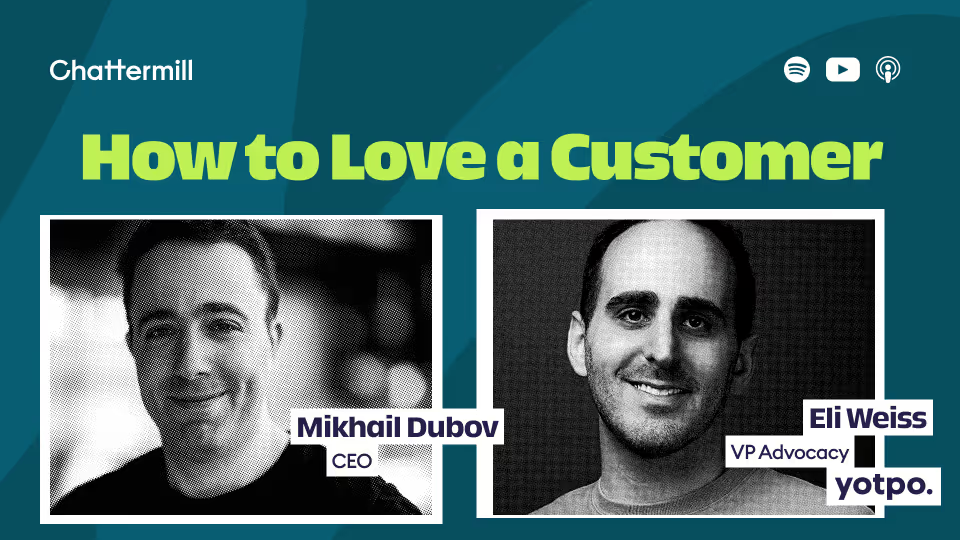We’re fresh from our Berlin event, Understanding the competitive value of AI in CX.
Chattermill was joined by 20 customers, partners, and friends who wanted to make sure that their choice of AI backs up business outcomes. To unlock the full value of AI in CX programs it needs to be integrated and to support the work that is being done upstream and downstream. Without the right inputs, the wrong decisions are made. Likewise, if the outputs are not utlilized nothing will change.
So, how can enterprises use CX to drive business outcomes?
To answer this question, we created a panel of leaders from top CX brands to discuss their experiences in the AI and CX space, the challenges they’ve faced, and how they manage the process alongside future potential.
The panel was chaired by Dave Ascott, Strategy Lead at Chattermill and included our incredible customers: Julia Zuber, Customer Insights Lead at Limehome and Shaahin Shariat, Director of Research and Insights at Blinkist. This is a summary of the discussion, shining a light on the best practices to make a lasting impact.
Here’s what you will learn today:
- How AI scales the voice of the customer across the entire journey
- What the future of AI looks like in travel and hospitality
- How to find the balance between AI and humans
- What enterprises can do to get the right business outcomes from AI
- How AI enables businesses to focus on strategic decisions
- Questions the audience asked and how our panelists responded
Here is the complete recording of the panel, so that you can watch it for the first time or revisit it for a second look.
AI isn’t brand new, but now it empowers every team across the customer journey
This may seem obvious, but the rapid development of AI has democratized CX across organizations. Now everyone can use data to improve customer experience.
According to Julia Zuber, AI didn’t just change her way of working - it also changed the way Limehome embedded the customer experience into its hospitality experiences.
She reflected, “I think especially when it comes to going somewhere you create experiences, you create memories. This is more connected to a feeling and capturing that without AI is not possible. So the entire way of generating exceptional experiences has changed at Limehome.”
There’s another use for CX technology specifically within product development. Blinkist uses AI to move away from inward looking business-centric decisions.
Shaahin said, “Traditionally we have a product trio - there is a Product Manager, a Designer, and an Engineer - but now we are adding our customer as a new member to that group.”
This means that the main opportunity with AI is to scale CX research. Shaahin observed that “the lines between the old-school methodology of qualitative and quantitative research are evaporating. We have loads of unstructured data coming in. We can quickly look at it. And it's coming from hundreds of interviews (not one survey) so our teams have much richer data.”
The future of AI looks different in both hospitality and travel
Our group of CX leaders knows that the future of AI will change the customer experience in different ways for various industries.
For example, Julia argued that there is the potential to move from reactive opportunities to proactive measures in hospitality. In explaining this, she says “I still see we could have so much more value if we're not just reacting on data that we get but if we can also predict data or human behavior. So everything can be unique for that one specific target group.”
The point is this: it’s essential to recognize that technology could completely change how we see the customer journey.
It’s not easy to find the right balance between AI and humans
When it comes to the pull between making decisions that drive business goals and individual team KPIs, it’s important to reduce the workload required it is important to reduce the workload required for individuals to be able to make tactical decisions.
Shaahin said “we want these kinds of things to be more democratized. But is it good enough and is it trustworthy enough? There are a lot of people that think AI can do everything. Where do we draw the line of what AI is good at?”
He continues that in subscriptions specifically, “One of the key points people actually love our product is because people create that content. There is a lot of desire to go with AI doing that because we can do a lot more at cheaper rates but is that what customers want? Does something being created by a human give it more monetary value?”
Julia acknowledged that the challenge is significant at scale. She said “so I find it pretty difficult to find a way to have both approaches - AI up to a specific point, and then the human takes over. The problem is that this point is different for every person.”
Fundamentally, the issue comes back to what each customer wants. The idea here is simple: how companies use AI should be defined by what their customers need to drive their loyalty.
It’s critical to get the right business outcomes from AI
The future is important, but how do our panelists currently build it into their ways of working?
Shaahin describes as a test-and-learn approach to create new dimensions of the customer experience. He said, “you have this happy path that worked for the majority of people, and of course not for everyone. But with AI we can go much more granular and that has been really great to see like how, how personalized we can make that experience.”
If you’re looking for ways that AI can give you a competitive edge, try using it for competitive analysis. Julia said, “we also analyze competitors with AI. Whenever we feel like what competition X, Y, or Z is doing is interesting, we can see what we're still missing to create an exceptional customer experience. What is it that others are actually doing? Would it be worth it to merge with that company? Would it be an add-on for our customers?”
AI enables businesses to focus on strategic decisions
Our group of CX leaders knows that to drive success, there must be room for strategic decisions. But, avoiding a laundry list of fixes is hard to do.
Shaahin said, “Before AI, our researchers were focused on the stuff that needed to be done but they didn’t see much value in it. So it had a very short-term impact.”
As with a lot of businesses they found researchers' time was often taken up with pulling together data and reports rather than on more high-value strategic questions. The automation and the ability to self-serve that AI makes possible can have a massive impact here.
Shaahin explained, “Recently I see that shift already happening that when the team - thanks to Chattermill partly - come to us for a lot of questions. So they don’t go to the researcher every time to give them that report. The researcher can actually focus on something more strategic, something longer term, something like the future trends of the market.”
Questions and Answers
We opened the discussion to questions from the audience. Here are those with answers from our panelists.
How can we translate insights to different teams - how do you trust it and make it actionable?
Shaahin Shariat, Director of Research and Insights at Blinkist:
I can give an example of how we use Chattermill and share the insights. We do it in two ways, on two levels.
For the larger needs of the company, we integrated the Chattermill dashboard into Slack. The team creates certain dashboards and we push out those dashboards on a regular basis for everyone's visibility.
And then within the research and CX team, we share more granular things on a one-to-one level. So, if we have a UX researcher working with a product team to create a customized functionality, we raise it in their weekly standup or catch-ups and they go through those more detailed things together.
One more thing is that also from the leadership side, I make sure that I bring Chattermill insights top of mind before answering any questions. Instead of immediately answering you need to help them change their behavior, so gently nudging them to look at what they can find there. And if you repeat again and again at some point, the behavior will change.
How do you increase adoption and drive self-service within your organization?
Julia Zuber, Customer Insights Lead at Limehome:
What I do is give introductions to Chattermill when someone new starts. Thankfully the tool is very user friendly and it's also fun to use. I give them little projects and show them what they can do for their departments. When they see how easy it is they start doing it themselves.
What I also do is I try in every department to find a person who is actually really good at Chattermill and and can be an ambassador for the entire team to create e a little bit of publicity for using it.
How do you convince guests who have a different understanding of service based on face-to-face interaction to use a chatbot or AI?
Julia Zuber, Customer Insights Lead at Limehome:
So what we try to do is that we try to use both. Obviously, you will never have a direct experience like that with real hotel staff and people who are willing to listen. We try to give our AI as much of a human touch as possible. We built a digital reception in which the guest receives personalized information to his trust preferences. At every touchpoint on the digital journey, he will find a phone number or a call to action so that he can reach a human being.
When you have quite general feedback how do you really drill in and get down to that kind of insightful feedback that's going to impact your business objectives?
Julia Zuber, Customer Insights Lead at Limehome:
What we do is once we find out what the pain points are we assess a way to work out how painful it really is for the guests within the customer journey. Is it super painful? Does it really really break the customer journey?
For example, in the middle of the night, it's raining cats and dogs and he's standing in front of the door and he doesn't get in because he doesn't have a code. Obviously, that's the greatest pain point that guests can ever experience. Whereas when there's a spoon missing or there is no hairdryer, for example, that's probably not so bad.
We really try to focus on the specific pain points and ask ourselves this: How bad is it for the guest that he's experiencing that? Then we prioritize our activities. What do we have to really address first, but what's the highest priority? And what comes last?















